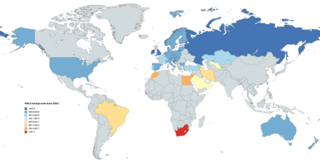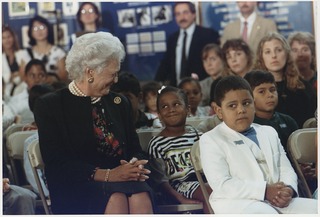Related Research Articles
Psychological testing refers to the administration of psychological tests. Psychological tests are administered or scored by trained evaluators. A person's responses are evaluated according to carefully prescribed guidelines. Scores are thought to reflect individual or group differences in the construct the test purports to measure. The science behind psychological testing is psychometrics.

Standardized test is a test that is administered and scored in a consistent, or "standard", manner. Standardized tests are designed in such a way that the questions and interpretations are consistent and are administered and scored in a predetermined, standard manner.

Youth is the time of life when one is young. The word, youth, can also mean the time between childhood and adulthood (maturity), but it can also refer to one's peak, in terms of health or the period of life known as being a young adult. Youth is also defined as "the appearance, freshness, vigor, spirit, etc., characteristic of one, who is young". Its definitions of a specific age range varies, as youth is not defined chronologically as a stage that can be tied to specific age ranges; nor can its end point be linked to specific activities, such as taking unpaid work, or having sexual relations.
Antisocial behaviours, sometimes called dissocial behaviours, are actions which are considered to violate the rights of or otherwise harm others by committing crime or nuisance, such as stealing and physical attack or noncriminal behaviours such as lying and manipulation. It is considered to be disruptive to others in society. This can be carried out in various ways, which includes, but is not limited to, intentional aggression, as well as covert and overt hostility. Anti-social behaviour also develops through social interaction within the family and community. It continuously affects a child's temperament, cognitive ability and their involvement with negative peers, dramatically affecting children's cooperative problem-solving skills. Many people also label behaviour which is deemed contrary to prevailing norms for social conduct as anti-social behaviour. However, researchers have stated that it is a difficult term to define, particularly in the United Kingdom where many acts fall into its category. The term is especially used in Irish English and British English.

The Survey of Income and Program Participation (SIPP) is a statistical survey conducted by the U.S. Census Bureau. The SIPP is designed to provide accurate and comprehensive information about the incomes of American individuals and households and their participation in income transfer programs.

A personality test is a method of assessing human personality constructs. Most personality assessment instruments are in fact introspective self-report questionnaire measures or reports from life records (L-data) such as rating scales. Attempts to construct actual performance tests of personality have been very limited even though Raymond Cattell with his colleague Frank Warburton compiled a list of over 2000 separate objective tests that could be used in constructing objective personality tests. One exception, however, was the Objective-Analytic Test Battery, a performance test designed to quantitatively measure 10 factor-analytically discerned personality trait dimensions. A major problem with both L-data and Q-data methods is that because of item transparency, rating scales, and self-report questionnaires are highly susceptible to motivational and response distortion ranging from lack of adequate self-insight to downright dissimulation depending on the reason/motivation for the assessment being undertaken.
A longitudinal study is a research design that involves repeated observations of the same variables over long periods of time. It is often a type of observational study, although it can also be structured as longitudinal randomized experiment. This research design assumes an alternative name 'panel studies' when the repeated research utilizes the same sample size.
The National Center for Education Statistics (NCES) is the part of the United States Department of Education's Institute of Education Sciences (IES) that collects, analyzes, and publishes statistics on education and public school district finance information in the United States. It also conducts international comparisons of education statistics and provides leadership in developing and promoting the use of standardized terminology and definitions for the collection of those statistics. NCES is a principal agency of the U.S. Federal Statistical System.
An Individualized Education Program (IEP) is a legal document under United States law that is developed for each public school child in the U.S. who needs special education. It is created through a team of the child's parent(s) and district personnel who are knowledgeable about the child's needs. IEPs must be reviewed every year to keep track of the child's educational progress.
The National Longitudinal Surveys (NLS) are a set of surveys sponsored by the Bureau of Labor Statistics (BLS) of the U.S. Department of Labor. These surveys have gathered information at multiple points in time on the labor market experiences and other significant life events of several groups of men and women. Each of the NLS samples consists of several thousand individuals, many of whom have been surveyed over several decades.

The IEA's Progress in International Reading Literacy Study (PIRLS) is an international study of reading (comprehension) achievement in 9-10 year olds. It has been conducted every five years since 2001 by the International Association for the Evaluation of Educational Achievement (IEA). It is designed to measure children's reading literacy achievement, to provide a baseline for future studies of trends in achievement, and to gather information about children's home and school experiences in learning to read.
The Multiple Indicator Cluster Surveys (MICS) are household surveys implemented by countries under the programme developed by the United Nations Children's Fund to provide internationally comparable, statistically rigorous data on the situation of children and women. The first round of surveys (MICS1) was carried out in over 60 countries in mainly 1995 and 1996 in response to the World Summit for Children and measurement of the mid-decade progress. A second round (MICS2) in 2000 increased the depth of the survey, allowing monitoring of a larger number of globally agreed indicators. A third round (MICS3) started in 2006 and aimed at producing data measuring progress also toward the Millennium Development Goals (MDGs), A World Fit for Children, and other major relevant international commitments. The fourth round, launched in 2009, aimed at most data collection conducted in 2010, but in reality most MICS4s were implemented in 2011 and even into 2012 and 2013. This represented a scale-up of frequency of MICS from UNICEF, now offering the survey programme on a three-year cycle. The fifth round, launched in 2012, was aimed at offering countries the tools to do the final MDG data collection.
"Youth Marketing" is a term used in the marketing and advertising industry to describe activities to communicate with young people, typically in the age range of 11 to 35. More specifically, there is teen marketing, targeting people age 11 to 17, college marketing, targeting college-age consumers, typically ages 18 to 24, and young adult marketing, targeting ages 25 to 34.
The Das–Naglieri cognitive assessment system (CAS) test is an individually administered test of cognitive functioning for children and adolescents ranging from 5 through 17 years of age that was designed to assess the planning, attention, simultaneous and successive cognitive processes as described in the PASS theory of intelligence.

Literacy in the United States was categorized by the National Center for Education Statistics into different literacy levels, with 92% of American adults having at least "Level 1" literacy in 2014. Nationally, over 20% of adult Americans have a literacy proficiency at or below Level 1. Adults in this range have difficulty using or understanding print materials. Those on the higher end of this category can perform simple tasks based on the information they read, but adults below Level 1 may only understand very basic vocabulary or be functionally illiterate. According to a 2020 report by the U.S. Department of Education, 54% of adults in the United States have English prose literacy below the 6th-grade level.
Display rules are a social group or culture's informal norms that distinguish how one should express themselves. They function as a way to maintain the social order of a given culture, creating an expected standard of behaviour to guide people in their interactions. Display rules can help to decrease situational ambiguity, help individuals to be accepted by their social groups, and can help groups to increase their group efficacy. They can be described as culturally prescribed rules that people learn early on in their lives by interactions and socializations with other people. Members of a social group learn these cultural standards at a young age which determine when one would express certain emotions, where and to what extent.
Victimisation is the state or process of being victimised or becoming a victim. The field that studies the process, rates, incidence, effects, and prevalence of victimisation is called victimology.
Professor Wei-Jun Jean Yeung is a Taiwanese sociologist and demographer, now is the professor of Asia Research Institute, National University of Singapore. She chairs the Family, Children, and Youth Research Cluster in the Faculty of Arts and Social Sciences in NUS.
Adolescent sexuality in Canada is not as well documented as adolescent sexuality in the United States; despite the proximity of the two nations, Canada has its own unique culture and generalizations about Canadian adolescent sexuality based on American research can be misleading. Because of this, several surveys and studies have been conducted which acquired information on Canadian adolescent sexuality. Surveys which provide this information include the Canadian Community Health Survey (CCHS), the National Population Health Survey (NPHS) and the National Longitudinal Survey of Children and Youth (NLSCY). According to information drawn from the Canadian Community Health Survey and the National Population Health Survey, in 2005 43% of teens aged 15 to 19 reported that they had had sexual intercourse at least once.

J. Douglas Willms is the Founder and President of The Learning Bar Inc. He is a member of the US National Academy of Education, Past-President of the International Academy of Education and a Fellow of the Royal Society of Canada. From 1995 to 2018, Willms was Professor of Education at the University of New Brunswick, where for eight years he held the Canadian Institute for Advanced Research Chair in Human Development and for fourteen years held the Tier 1 Canada Research Chair in Literacy and Human Development.
References
- ↑ Canada, Government of Canada, Statistics. "National Longitudinal Survey of Children and Youth (NLSCY)". www23.statcan.gc.ca. Retrieved June 28, 2018.
{{cite web}}: CS1 maint: multiple names: authors list (link)